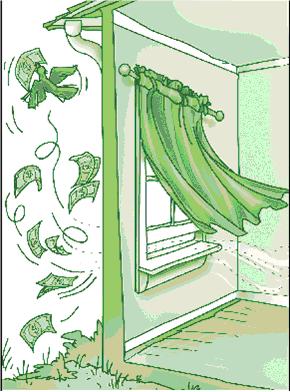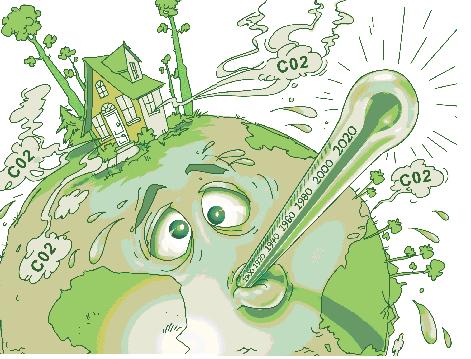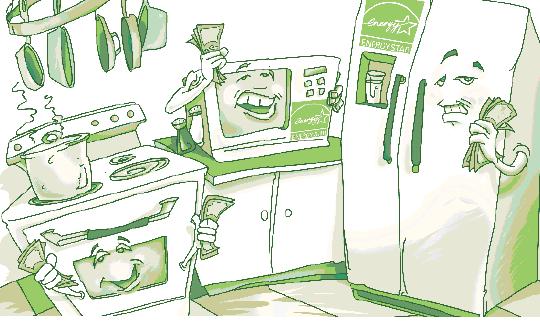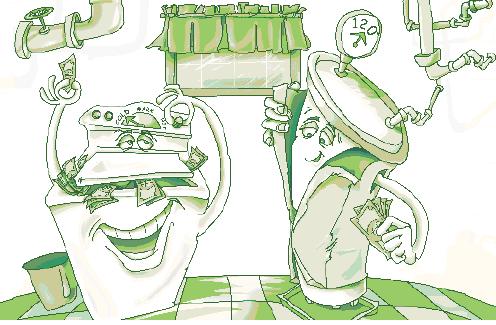Technical Paper Title: Power Smart
Authors: K.Swathi & T Sravanthi, 1st BTech, EEE
Guide: Prof. Meeravali
College: Prakasam Engineering College, Kandukur
Energy used to heat our home and power our TV is not too different from the energy our body gets when we eat a slice of pizza. Our body is like a powerhouse, turning food (fuel) into usable energy and waste byproducts.
A power plant does the same thing: Coal, oil, or natural gas (nonrenewable fossil fuels) goes in and gets burned up to power a big generator that sends energy to our house, with carbon dioxide, some noxious gases, and/or sludge as waste byproducts. The problem: fossil fuels (from fossils, or remains, of dead animals and plants) take millions of years to make. The volume of byproducts created when we burn fossil fuels is not easily reprocessed in our environment and causes pollution and related health problems.
FACT: Energy production and use account for nearly 80 percent of air pollution, more than 83 percent of greenhouse gas emissions, and more environmental damage than any other human activity.
THE POWER IS IN YOUR HANDS:
If you replaced just four 75-watt incandescent bulbs that burn four or more hours a day in your home with four 23-watt fluorescent bulbs, you’d get as much light and save more than 2,000 kilowatt-hours (kWh) of electricity and $190 over the 10,000-hour life of the bulbs. If all our nation’s households did the same, we’d save as much energy as is consumed by some 38 million cars in one year.
ENERGY EFFICIENCY AND ENERGY CONSERVATION
Energy efficiency and conservation means getting the most from every energy unit. Energy efficiency involves investment in state-of-the-art technologies and regular maintenance of energy-using equipment. Energy efficiency measures range from installing lighting control systems to maintaining proper tire pressures. Energy conservation usually involves changes in habits and other no-cost actions, such as turning off lights when not in use, reducing hot water heater temperatures, car-pooling and combining shopping trips. Energy efficiency and conservation are the cheapest, cleanest way to reduce energy use, energy prices, and pollution, and extend our nation’s energy supplies.
For example, compact fluorescent bulbs save energy through technology. They use about one third of the energy of typical incandescent bulbs, last up to ten times longer, and generally pay back their higher purchase price in two years through lower utility bills. Turning off lights represents good energy conservation practices. Doing both is smart.
POWER $MART TIPS :
PUT THE POWER IN YOUR HANDS
Look for home and office products that have earned the ENERGY STAR®. These products have met energy efficiency guidelines set by the Environmental Protection Agency (EPA) and DOE. The ENERGY STAR® can be found on more than 40 product categories in your home, such as appliances, heating and cooling equipment, consumer electronics, office equipment, lighting fixtures and bulbs and new homes.
FACT: Households that replace existing equipment with ENERGY STAR® qualified products can cut annual energy bills by 30 percent, or more than $450 per year.
A typical house releases 22,000 pounds of carbon dioxide (CO2) annually, almost twice as much as a typical car’s annual 11,500 pounds of CO2 emissions, estimates EPA. This is due to emissions produced by power plants that generate the electricity used to run modern homes—plus home emissions from such things as oil or gas-fired furnaces.
Many prominent scientists believe CO2 is contributing to global climate change. Unfortunately, we don’t even benefit from a lot of the energy we use. Energy dollars pour out of homes through drafty doors and windows and uninsulated attics, walls, floors and basements. Even some idle (turned off) appliances use energy 24 hours a day!
FACT: The energy use of two families living in two homes that look EXACTLY alike can vary by 100 percent—which means that how you use what’s in your home can double (or halve) your energy bills.
IS YOUR HOME LEAKING ENERGY DOLLARS?

Perhaps your home wasn’t built using today’s high-quality, energy-efficient products or techniques. Perhaps previous occupants never took care of problems. Perhaps your heating and cooling bills are higher than you’d like. Where might energy be leaking from your home?
It might be going out the window—literally. Some homes have enough leaks around windows and doors to equal a wide open three foot by three foot window! Check your home’s first line of defense against the elements—the outer shell—the roof, walls, floors, windows, and doors. It pays to deal with air leaks first to get the maximum savings from your heating and cooling systems and other energy-efficiency measures.
POWER $MART TIPS : PUT THE POWER IN YOUR HANDS
* Installing appropriate insulation for your climate (based on R-values) can increase your comfort, make your home quieter and cleaner, and reduce your heating and cooling costs up to 20 percent. Start with attic insulation, followed by exterior and basement walls, floors, and crawl spaces.
* If you’re shopping for new windows, glass doors, or skylights, look for the ENERGY STAR®. Today’s ENERGY STAR® qualified high-efficiency windows with double or triple panes can save $125 to $340 per household annually over single pane windows, depending on climate. They also improve comfort in both winter and summer.
* Find and plug those leaks. On a windy day, hold a lit incense stick next to your doors, windows, fixtures and electrical outlets to check for drafts. Or wet your fingertips and run them around the door or window frame—or hold up a tissue and see if it waves. Seal leaks between moving parts (between door or window and its frame) with weather-stripping. Fill leaks between nonmoving parts (between window frame and wall) with long-lasting indoor/outdoor clear caulk.
* Install storm windows if you only have single-pane windows. If you can’t afford that, consider temporary fixes for your older or leaky windows, such as plastic film kits that create the effect of an interior storm window.
FACT: Gas-filled, double-pane windows with low-e coatings, such as those recommended by ENERGY STAR, ® not only can lower your heating and cooling bills by as much as 30 percent, but will also increase comfort, reduce fading of home furnishings, reduce maintenance, and increase the resale value of your home.
. * When replacing a furnace, air conditioner, or heat pump, look for the ENERGY STAR®. You can get additional information from the yellow Energy Guide label to compare every model in a category, its capacity, and estimated yearly energy cost.
* ENERGY STAR® qualified geothermal heat pumps use the constant temperature of the earth to efficiently transfer heat to the home in winter or cool air to the home in summer. They require adequate land and an added up front expenditure.
* If you have a heat pump, dramatically turning up the heat by hand is costly because it may trigger the inefficient electric backup heater, eating up any savings from reducing the thermostat. (A programmable thermostat designed for heat pumps will gradually raise the heat without activating the backup heat.)
* When adjusting the thermostat by hand, remember that the house will not warm up or cool down any faster if you crank up the thermostat past the desired temperature. Besides, it is easy to forget to turn it back down, which will waste energy dollars.
* Poor performing ducts can leak conditioned air and reduce your system’s efficiency. Sealing duct air leaks and insulating ducts in attics and crawlspaces can improve comfort and save energy.
* Clean or replace furnace and air conditioner filters once a month during heating/cooling season.
FACT: An ENERGY STAR® qualified furnace or air conditioning system, when properly sized and installed, along with sealed ducts and a properly used programmable thermostat, can save consumers as much as 20 percent on heating and cooling bills.
FACT: For each degree you lower your thermostat in winter, you can save up to 5 percent on the heating portion of your energy bill (depending on your climate region).
Your thermostat controls the heating and cooling system that consumes more than half of the energy in your home—the biggest chunk of your family’s energy budget. How much of that energy is used to keep your house comfortable when no one is home or everyone is asleep? Probably a lot, if you don’t adjust the thermostat when you leave the house or go to bed.
Introducing the programmable thermostat! It automatically coordinates the temperature of your home with your daily and weekly/weekend patterns—so you don’t awaken to a chilly bedroom in winter or come home to a stuffy house in summer. Once you make the settings, you don’t have to adjust the thermostat again.
POWER $MART TIPS : PUT THE POWER IN YOUR HANDS
* When replacing a furnace, air conditioner, or heat pump, look for the ENERGY STAR®. You can get additional information from the yellow Energy Guide label to compare every model in a category, its capacity, and estimated yearly energy cost.
* ENERGY STAR® qualified geothermal heat pumps use the constant temperature of the earth to efficiently transfer heat to the home in winter or cool air to the home in summer. They require adequate land and an added up front expenditure.
* If you have a heat pump, dramatically turning up the heat by hand is costly because it may trigger the inefficient electric backup heater, eating up any savings from reducing the thermostat. (A programmable thermostat designed for heat pumps will gradually raise the heat without activating the backup heat.)
* When adjusting the thermostat by hand, remember that the house will not warm up or cool down any faster if you crank up the thermostat past the desired temperature. Besides, it is easy to forget to turn it back down, which will waste energy dollars.
* Poor performing ducts can leak conditioned air and reduce your system’s efficiency. Sealing duct air leaks and insulating ducts in attics and crawlspaces can improve comfort and save energy.
* Clean or replace furnace and air conditioner filters once a month during heating/cooling season.
FACT: An ENERGY STAR® qualified furnace or air conditioning system, when properly sized and installed, along with sealed ducts and a properly used programmable thermostat, can save consumers as much as 20 percent on heating and cooling bills.
FACT For each degree you lower your thermostat in winter, you can save up to 5 percent on the heating portion of your energy bill (depending on your climate region).
LIGHT UP YOUR LIFE
Nearly 10 percent of the average home’s electricity costs can be controlled with the flip of a switch—a light switch—notes EPA. So how can you light the house more efficiently?
A good solution: Compact fluorescent bulbs (CFLs) use about two-thirds less energy and last up to 10 times longer than incandescent bulbs. CFLs have improved tremendously since first introduced; they have become smaller, cheaper, brighter, and offer improved color quality.
POWER $MART TIPS : PUT THE POWER IN YOUR HANDS
* Don’t like coming home to a dark house? Instead of leaving lights on, put timers on a few of the lights in your home, or install motion detectors on exterior flood lights to improve your home security. After you get inside, the sensor will “remember” to turn the lights off.
* Replace all light fixtures and bulbs that operate four or more hours a day with compact fluorescent bulbs to save money and energy. Use lumens—the amount of light produced—to compare lights. For example, a 23-watt fluorescent bulb produces about the same number of lumens as a 75-watt incandescent. Your investment will generally pay for itself in a couple of years.
* Let “Mother Nature” light your home. Sunlight is brighter than a multitude of light bulbs, and it’s free.
* Turn off all lights not in use to save money and energy.
HOME COOKING
The kitchen uses a big chunk of your home energy budget. Your refrigerator alone—which is on 24 hours a day— accounts for about 10 percent of the total home electricity bill. So where can you apply energy efficiency in the kitchen?
Shopping for a major appliance before the old one breaks down gives you the best chance to find a higher efficiency model with the features you want. The typical refrigerator sold today has more features yet uses less than half the electricity of a comparable model sold in 1980. Choose ENERGY STAR® appliances to ensure greatest efficiency and energy savings.
POWER $MART TIPS : PUT THE POWER IN YOUR HANDS
* Buy a new fridge that is the right size for your needs to avoid wasting energy cooling nothing.
* Use a microwave or toaster oven to cook small portions and a conventional oven or stove-top for larger items.
* A watched pot will eventually boil—but putting a lid on it reduces cooking time and energy use. Also, match the pot size to burner size to avoid energy waste.
COMING CLEAN
From gym clothes to water glasses, there’s no shortage of washing to do around the home—all of which takes energy. Just making hot water uses about 15 percent of your home energy budget.
Many new innovations in the cleaning department save energy. One of the simplest and least expensive is a low-flow shower head—a familiar technology that has improved from earlier versions. It can cut your shower water use in half while maintaining the same pressure as before.
POWER $MART TIPS : PUT THE POWER IN YOUR HANDS
If you are in the market for new appliances, look for ENERGY STAR® qualified products with these energy-saving features:
* Dishwashers that use soil sensors to shorten the washing cycle, saving water and energy.
* Clothes dryers that have moisture sensors, turning off the unit when the clothes are dry.
* Clothes washers that use less water and energy than less efficient models.
* Set your hot water heater thermostat at 120 degrees. It’s hot enough for most needs—including dishwashers, which generally are made with booster heaters—and it cuts down on energy needed to keep water hot in the tank.
* Wrap your hot water tank in an insulating “blanket” if it feels warm to the touch.
* Use cold water for laundry to save up to $63 a year. Today’s cold water detergents do a good job.
* Wash only when you have full loads.
TOO ‘PLUGGED IN
Our consumer-oriented society, the growth of new technologies, and the fact that more people are working from home have dramatically increased the number of products that require power in the average home. The average home has roughly 2 TVs, a VCR, a DVD player and 3 telephones. Replacing these items with ENERGY STAR® models—which use as much as 50 percent less energy—would save more than 25 billion pounds of greenhouse gas emissions, the equivalent to taking 3 million cars off the road for one year, according to EPA.
Many idle appliances—TVs, VCRs, cable boxes, DVD and CD players, cassette decks, cordless phones, burglar alarms, microwaves—continue to consume energy when switched off. This energy keeps display clocks lit and memory chips and remote controls working. Lawrence Berkeley National Laboratory calculates that these energy “leaks” account for 5 percent of total domestic electricity consumption, cost more than $4 billion annually, and spew 12 million tons of carbon into the atmosphere.
POWER $MART TIPS : PUT THE POWER IN YOUR HANDS
* Buy ENERGY STAR®-labeled electronics. Make sure you are using the power management or “sleep” feature on ENERGY STAR® qualified home office equipment (PC, fax, printer, scanner) so that they automatically power down when not in use to save up to $70 annually in electricity bills and improve product longevity.
* Turning off your computer and electronics during long periods of non-use cuts costs and improves longevity.
FACT:By 2015, consumer electronics and small appliances will be responsible for almost 30 percent of all household electricity use.
Using fuel to power the vehicles has enormous impact on the nation’s environment and national security, as well as family budgets.
POWER $MART TIPS : PUT THE POWER IN YOUR HANDS
* If you are in the market for a new car, think high gas mileage to save hundreds of dollars in fuel bills over the life of the car and reduce pollution and greenhouse gas emissions.
* Purchase the most fuel-efficient vehicle in a particular class and save up to $300-$700 in fuel costs per year. And by purchasing a vehicle that gets five more miles per gallon than your current vehicle, you can avoid emitting about 17 tons of greenhouse gases over the lifetime of the vehicle.
* Keep your car properly tuned up to improve gas mileage by about 4 percent.
* Replace a faulty oxygen sensor to improve mileage by as much as 40 percent. Keep air filters clean to improve mileage by as much as 10 percent.
* Keep tires properly inflated to improve gas mileage by as much as 3 percent.
* Obey the speed limit because speeding cuts fuel economy 7 to 23 percent, as gas mileage decreases rapidly above 60 mph.
MOVING ON UP: ENERGY EFFICIENT HOMES

Looking to rent or buy a new home? If you have previously experienced costly repairs to achieve savings and comfort, you may know the value of a quality, energy-efficient home.
POWER $MART TIPS : PUT THE POWER IN YOUR HANDS
* Look for new homes with the ENERGY STAR®. They are certified to use at least 30 percent less energy than required by the national Model Energy Code or 15 percent less energy than the state energy code, whichever is more rigorous, and typically feature high-performance windows, advanced insulation and sealing, and high-efficiency appliances and heating/cooling systems.
* Obtain a home energy rating to determine a home’s relative energy efficiency prior to purchasing to see what upgrades would have the greatest payoff. The cost can sometimes be financed as part of an energy-efficient mortgage.
* If you are refinancing your home, consider wrapping in energy-efficiency home improvements. Your interest may be tax deductible.
* Consider landscaping around the home. Planting evergreen trees on the north side and deciduous (leafy) trees on the south side of a home can block winter winds and summer sun.







